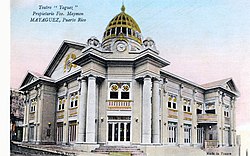Teatro Yagüez
|
Teatro Yaguez
|
|
 |
|
| Location |
Calle Candelaria y Calle Dr. Basora Mayagüez, Puerto Rico |
|---|---|
| Coordinates | 18°12′4.39″N 67°8′24.75″W / 18.2012194°N 67.1402083°WCoordinates: 18°12′4.39″N 67°8′24.75″W / 18.2012194°N 67.1402083°W |
| Area | 0.2 acres (0.081 ha) |
| Built | 1909 |
| Architect | Sabas Honore et al. |
| NRHP Reference # | 85003086 |
| Added to NRHP | December 2, 1985 |
The Teatro Yagüez in Puerto Rico is a historic building that today is a performing arts theater. It is located at Candelaria Street,(formerly Calle McKinley) and Dr. Basora Streets, in the city of Mayagüez. It consists of the Lucy Boscana Hall and the Roberto Cole Cafe Theater.
It was originally erected by Francisco Maymón Palmer in 1909. Mr. Maymón's parents emigrated to Puerto Rico from Italy in the 19th century. They settled in the town of San German. Early in the 20th century Francisco tried to build a theatre in the town of San German but was unable due to the existing religious culture then, which considered a theatre as a "bad influence' on the local population. Maymón was an entrepreneur by vocation, having travelled to Europe and the United States in his 20s, and he would not be stopped. He moved to the nearby city of Mayaguez where he established himself as one of the pioneers of the industry of cinematography in the island of Puerto Rico, introducing this new form of Visual Art early in the beginning of the 20th century by showing silent films throughout the nearby towns and becoming the exclusive distributor for 'Nicholas Power Co.' movie projectors throughout the Caribbean islands. The 'Nicholas Power Company' was located in New York. With the help of his business partners Mr. Jose Rahola and Mr. Fundador Vargas, he imported movies from the Pathé Company in Europe, showing them in town centers (plazas) under the stars and at the old Mayaguez Municipal Theater ('Teatro Municipal'). The latter no longer exists, as it was destroyed in the 1918 earthquake that hit the city and was never rebuilt, hence the Teatro Yagüez became the city's preferred gathering place for opera, plays, concerts, and silent movies.
Francisco purchased the land where the Yaguez sits today around 1905. The construction of the first Teatro Yagüez building began around 1907; The formal inauguration was in 1909. Materials such as the cement was imported from Germany, interior ceilings from Italy, tiles and carpets from Spain. An architectural jewel, the Teatro Yagüez began as a neo-baroque style Opera House, years later turning into a silent movie theater. Incorrectly described as art deco style, however, the art deco movement developed years after the theater's first construction and later reconstruction.
...
Wikipedia

